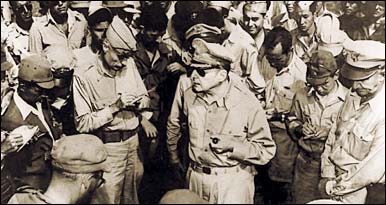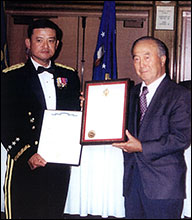 After the War and the MIS Contribution
After the War and the MIS Contribution
After the war, MIS soldiers played a critical role in the occupation of Japan serving as a vital link between General Douglas Macarthur and the Japanese people. With their knowledge of Japanese language and culture, the Nisei of the MIS helped to secure the peace and establish Japan’s democratic institutions. They assisted in every aspect of Japan’s reconstruction, from land reform and education to civil and legal affairs.
The MIS contributed to Japan’s transition from a country ravaged by war to a great economic power and one of America’s most important allies. Just as the Golden Gate Bridge symbolizes the historical linkage between East and West, the MIS “goodwill ambassadors” represented a vital bridge between the United States and Japan in the critical postwar years.
The MIS also paved the way for integrating language in military planning and operations, a role consistent with the postwar policy of international engagement. Today, foreign language skills are integral to military intelligence collection and analysis. In fact, the Defense Language Institute the military’s premier language training school, located in Monterey, California, traces its origins directly to the modest classroom located in Building 640 on the grounds of the Presidio.
The MIS Story — its contribution to the war effort, to the rebuilding of Japan, to the development of national security capabilities, and its significance to the larger American story — went largely unrecognized until fairly recently. Because of the service’s highly classified mission, the very existence of the MIS only became known to the general public with the passage of the Freedom of Information Act of 1971.
 In recent years, thanks to Congressional advocacy, MIS veterans have been accorded a measure of recognition by the US Government. Scores of MIS veterans have belatedly received medal upgrades, from the Bronze Star to the Distinguished Service Medal. In 2000, the Presidential Unit Citation, the military’s highest unit decoration, was retroactively awarded to all members of the MIS who served in WWII, in recognition of their collective contribution to the war effort. The US Army has commissioned a comprehensive history of the MIS that is expected to shed further light on the scope and value of the MIS’s work. [PHOTO LEFT: General Eric Shinseki, Chief of Staff of the United States Army, presents the Presidential Unit Citation to the Military Intelligence Service veterans on 6/30/2000.]
In recent years, thanks to Congressional advocacy, MIS veterans have been accorded a measure of recognition by the US Government. Scores of MIS veterans have belatedly received medal upgrades, from the Bronze Star to the Distinguished Service Medal. In 2000, the Presidential Unit Citation, the military’s highest unit decoration, was retroactively awarded to all members of the MIS who served in WWII, in recognition of their collective contribution to the war effort. The US Army has commissioned a comprehensive history of the MIS that is expected to shed further light on the scope and value of the MIS’s work. [PHOTO LEFT: General Eric Shinseki, Chief of Staff of the United States Army, presents the Presidential Unit Citation to the Military Intelligence Service veterans on 6/30/2000.]
These promising but disparate efforts to honor and explain the significance of the MIS would find their highest expression in Building 640 project. The Interpretive Center would serve as a energizing source for not only the MIS in WW II and after, but for as a multi-cultural space for debate on minority, civil liberties and justice issues world-wide.

 After the War and the MIS Contribution
After the War and the MIS Contribution In recent years, thanks to Congressional advocacy, MIS veterans have been accorded a measure of recognition by the US Government. Scores of MIS veterans have belatedly received medal upgrades, from the Bronze Star to the Distinguished Service Medal. In 2000, the Presidential Unit Citation, the military’s highest unit decoration, was retroactively awarded to all members of the MIS who served in WWII, in recognition of their collective contribution to the war effort. The US Army has commissioned a comprehensive history of the MIS that is expected to shed further light on the scope and value of the MIS’s work. [PHOTO LEFT: General Eric Shinseki, Chief of Staff of the United States Army, presents the Presidential Unit Citation to the Military Intelligence Service veterans on 6/30/2000.]
In recent years, thanks to Congressional advocacy, MIS veterans have been accorded a measure of recognition by the US Government. Scores of MIS veterans have belatedly received medal upgrades, from the Bronze Star to the Distinguished Service Medal. In 2000, the Presidential Unit Citation, the military’s highest unit decoration, was retroactively awarded to all members of the MIS who served in WWII, in recognition of their collective contribution to the war effort. The US Army has commissioned a comprehensive history of the MIS that is expected to shed further light on the scope and value of the MIS’s work. [PHOTO LEFT: General Eric Shinseki, Chief of Staff of the United States Army, presents the Presidential Unit Citation to the Military Intelligence Service veterans on 6/30/2000.]
